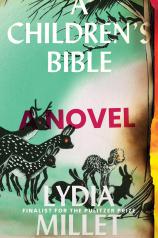A Children's Bible
Review
A Children's Bible
In her latest novel, A CHILDREN’S BIBLE, the supremely talented Lydia Millet once again shows her ability to turn on a dime, to create a situation that is laugh-out-loud funny and --- in a split second --- shift it into something that is dark and deadly serious.
That turn happens countless times throughout the book. As a result, thanks to Millet’s whip-smart writing, you may never look at your summer vacation house the same way again. The scene at the start of the story is a massive summer house, which has been rented by a large group of families. Most of them have teenage children, who are so desperate to distance themselves from their clueless and frankly infantile parents that they’re playing a game in which the winner is the last one standing, whose parentage has not been revealed or guessed correctly by the others.
"[T]he supremely talented Lydia Millet once again shows her ability to turn on a dime, to create a situation that is laugh-out-loud funny and --- in a split second --- shift it into something that is dark and deadly serious."
However, this distancing goes way beyond typical teenage alienation and rebellion. A CHILDREN’S BIBLE takes place seemingly in the near future, when climate catastrophe is a looming certainty. Teenager Eve, the narrator, notes that she and her peers are aware that the world --- “the familiar world, anyway” --- is on the verge of collapse, even if their parents suggest that perhaps the climate emergency could be averted if more people switch to electric cars. “That was how we could tell it was serious. Because they were obviously lying. We knew who was responsible, of course; it had been a done deal before we were born.” Eve breaks the news to her younger brother, Jack, and compares the experience to telling the truth about Santa Claus.
In this case, though, it’s the parents, not the children, who seemingly believe in fairy tales. Even Jack --- inspired by the stories in the children’s Bible he’s been given --- takes his role incredibly seriously as a massive storm bears down on the region, playing the part of Noah and gathering up animals for safekeeping. As the storm approaches and the parents appear too addled by drugs, orgiastic sex and possibly dengue fever to care much about the impending disaster, the kids take their safety into their own hands and head to higher ground, only to encounter new kinds of danger --- and unexpected brushes with grace.
As you might have gathered, Millet’s novel is laden with Biblical references, from Eve’s name and Jack’s Noah fixation to a birth in a stable and a visitation by (trail) angels, fresh from the nearby Appalachian Trail. A CHILDREN’S BIBLE is also punctuated by scenes of dark violence and apocalyptic horror, but also by moments of great clarity and wonder. Precocious but innocent Jack develops a provocative theory of the Holy Trinity, where “God” is nature, “Jesus” is science (“Like, for science to save us we have to believe in it. And same with Jesus.”), and the “Holy Spirit” is poetry. As with everything else, it’s left to the children to make these kinds of connections and to stumble toward a path forward.
A CHILDREN’S BIBLE seems to suggest, in a bleak yet oddly hopeful way, that the older generation already has messed up the world beyond repair. So why not let a little child lead us?
Reviewed by Norah Piehl on May 15, 2020
A Children's Bible
- Publication Date: May 12, 2020
- Genres: Fiction
- Hardcover: 224 pages
- Publisher: W. W. Norton & Company
- ISBN-10: 1324005033
- ISBN-13: 9781324005032




